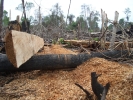 Among a total of 50 books tested by WWF Switzerland, five books contained “tropical mixed fibre”. This means that this paper has been made with tropical natural forest. WWF Switzerland bought 50 books in bookshops and kiosks and sent them to the “Institute for Paper Science and Technology” at the University of Darmstadt (Germany) to test their content. The results are troubling: the content of Mixed Tropical Timber ranges from 8 to 15 percent.
Among a total of 50 books tested by WWF Switzerland, five books contained “tropical mixed fibre”. This means that this paper has been made with tropical natural forest. WWF Switzerland bought 50 books in bookshops and kiosks and sent them to the “Institute for Paper Science and Technology” at the University of Darmstadt (Germany) to test their content. The results are troubling: the content of Mixed Tropical Timber ranges from 8 to 15 percent.
"The tropical wood used is probably from over-exploitation in tropical natural forests,” says Simone Stammbach from WWF Switzerland. The tropical fibre detected in the children books come from trees growing mainly in the natural rain-forests of Southeast Asia, where large-scale deforestation is occurring to feed the pulp mills or to make space to large scale acacia plantations. "The wood from precious tropical forests often ends up in cheap pulp for paper production" added Stammbach. Also the paper made from acacia could be linked to deforestation, if the plantations have been established by clearing natural forests.
All the books have been printed in Asia (or did not provide any information about the country of printing). European publishers print more and more books in Asia, particularly in China, the top importer of Indonesian pulp and paper. In recent years, China has become the hub for paper and printing and it is now the largest buyer of pulp, using around a quarter of the global production. This pulp is imported manly from Canada, USA, Brazil and Indonesia.
The involved publishers reacted in different ways: Wooky Europe decided not to comment, Usborne and Moewig requested further information, while Dispatch informed to have already switched towards FSC certified paper.


